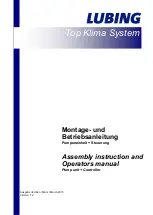
Sicherheitshinweise
Safety instructions
LUBING Top Klima System
- 9 -
LUBING Top Climate System
Sicherheitshinweise zu bestimmten Be-
triebsphasen
Normalbetrieb:
Gefahr!
Jede sicherheitsbedenkliche Arbeits-
weise unterlassen!
Maßnahmen treffen, damit die Maschine / Anla-
ge nur in sicherem und funktionsfähigem Zu-
stand betrieben wird!
Maschine nur betreiben, wenn alle Schutzein-
richtungen und sicherheitsbedingte Einrichtun-
gen wie z.B. lösbare Schutzeinrichtungen, Not-
Aus-Einrichtungen, Schalldämmungen, Absau-
geinrichtungen, vorhanden und funktionsfähig
sind!
Mindestens einmal pro Schicht Maschine / An-
lage auf äußerlich erkennbare Schäden und
Mängel prüfen! Eingetretene Veränderungen
(einschließlich des Betriebsverhaltens) sofort
der zuständigen Stelle / Person melden!
Maschine ggf. stillsetzen und sichern!
Bei Funktionsstörungen Maschine / Anlage so-
fort stillsetzen und sichern!
Störungen umgehend beseitigen lassen!
Ein- und Ausschaltvorgänge, Kontrollanzeigen
gemäß Betriebsanleitung beachten!
Vor Einschalten / Ingangsetzen der Maschine /
Anlage sicherstellen, daß niemand durch die an-
laufende Maschine / Anlage gefährdet werden
kann!
Sonderarbeiten im Rahmen der Nutzung der
Maschine / Anlage und Instandhaltungstätigkei-
ten sowie Störungsbeseitigung im Arbeitsablauf;
Entsorgung:
Wichtig:
In der Betriebsanleitung vorgeschrie-
bene Einstell-, Wartungs- und Inspektionstätig-
keiten und -termine einschließlich Angaben zum
Austausch von Teilen / Teilausrüstungen einhal-
ten! Diese Tätigkeiten darf nur Fachpersonal
durchführen.
Bedienungspersonal vor Beginn der Durchfüh-
rung von Sonder- und Instandhaltungsarbeiten
informieren! Aufsichtsführenden benennen.
Bei allen Arbeiten, die den Betrieb, die Produk-
tionsanpassung, die Umrüstung oder die Ein-
stellung der Maschine / Anlage und ihrer sicher-
heitsbedingten Einrichtungen sowie Inspektion,
Wartung und Reparatur betreffen, Ein- und Aus-
schaltvorgänge gemäß der Betriebsanleitung
und Hinweise für Instandhaltungsarbeiten be-
achten!
Instandhaltungsbereich,
soweit
erforderlich,
weiträumig absichern!
Savety instructions governing specific op-
erational phases
Standard operation:
Danger!
Avoid any operational mode that might
be prejudicial to savety!
Take the necessary precautions to ensure that
the machine is used only when in a safe and re-
liable state!
Operate the machine only if all protective and
savety-orientated devices, such as removable
savety devices, emergency shut-off equipment,
soundproofing elements and exhausters, are in
place and fully functional!
Check the machine / plant at least once per
working shift for obvious damage and defects.
Report any changes ( incl. changes in the ma-
chine's working behaviour ) to the competent
organization / person immediately. If necessary,
stop the machine immediately and lock it.
In the event of malfunctions, stop the machine /
plant immediately and lock it.
Have any defects rectified immediately.
During start-up and shot-down procedures al-
ways watch the indicators in accordance with
the operating instructions.
Before starting up or setting the machine / plant
in motion, make sure that nobody is at risk.
Special work in conjunction with utilization of
the machine / plant and maintenance and re-
pairs during operation; disposal of parts and
consumables:
Important:
Observe the adjustment, mainte-
nance and inspection activities and intervals set
out in the operating instructions, including in-
formation on the replacement of parts and
equipment. These activities may be executed
by skilled personnel only.
Brief operating personnel before beginning
special operations and maintenance work, and
appoint a person to supervise the activities.
In any work concerning the operation, conver-
sion or adjustment of the machine and its
savety-orientated devices or any work related to
maintenance, inspection and repair, always ob-
serve the start-up and shut-down procedures
set out in the operating instructions and the in-
formation on maintenance work.
Ensure that the maintenance area is adequately
secured.
Summary of Contents for Top Climate System
Page 2: ......










































